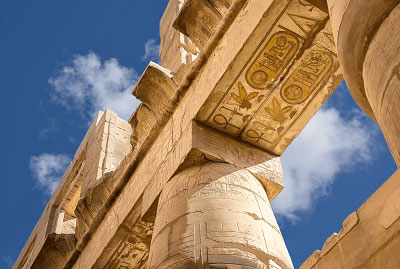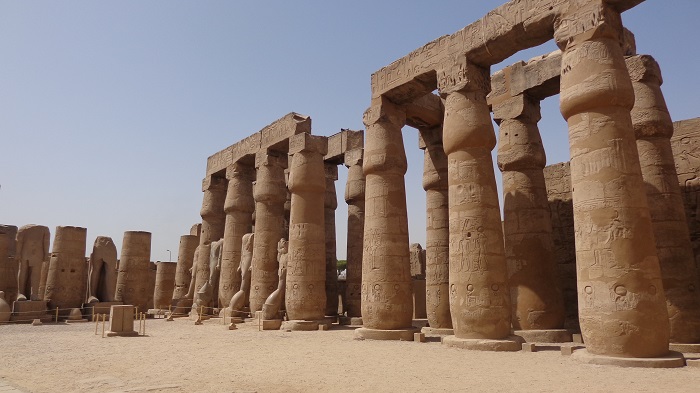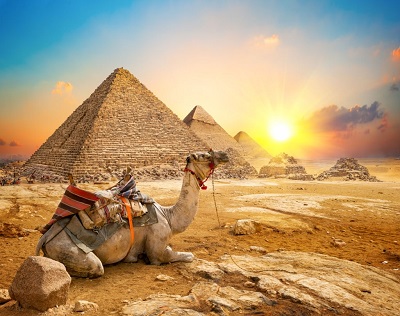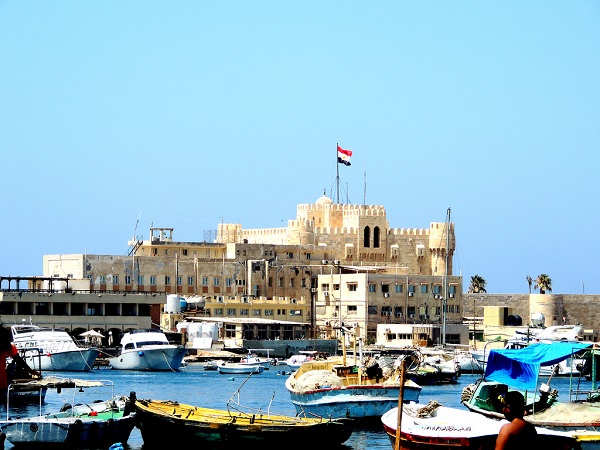Where is King Tut now?
Where is King Tut now? The collection contains about 1700 piece Click here to know where is the collection with...
Ancient Egyptian symbols has effected life in ancient Egypt which was a fusion between the spiritual and the physical aspects that became the foundation of their culture that showed in the form of artistic architecture, symbols, amulets, and many objects that were used to bring good fortune and protection. These ancient Egyptian Symbols played a vital role in passing the culture from one generation to another, as they were written on temple walls & obelisks and used in magical and religious rituals for both the living and the dead. The Egyptiian symbols were depicted in the form of hieroglyphs and treated as “The Words of Gods” which was used to document the most important events in ancient Egyptian History, their spiritual beliefs, and culture. Here are the top ancient Egyptian symbols:

The Eye of Horus (also called ‘wadjet’) is the symbol of power, protection and good health. Horus was a sky god who offered his left eye to his father, Osiris, in an attempt to bring him back to life. Due to its association with protection, many Ancient Egyptians wore the Eye of Horus as an amulet, and also placed them on the dead to protect them in the afterlife.

Not to be confused with the Eye of Horus, the Eye of Ra is distinguishable in that it is the right eye, rather than the left. Ra was an Egyptian sun god, and his eye is considered an extension of his power. While the Eye of Ra reflects many of the same concepts as the Eye of Horus, it also comes with an aspect of danger and violence, as it represents the heat and wrath of the sun.

The ankh is one of the most common ancient Egyptian hieroglyphs, used in art, writing and decorations. It represents the word “life” and life itself, as well as heaven, male & female, the morning sun, and the earth. It was often used to express the desire for someone to live – e.g. “may you live and be well”, and was held as a key to eternal life. Its beautiful shape was emulated by neighbouring cultures, who adapted it in many different ways, such as by using it as a variation of the Christian cross. Nowadays it is often associated with the Goth subculture.
Note: The Ankh is considered to be an ancient Egyptian symbol for Life, Protection, Faith, Energy, transformation, Light, and fertility. The Ankh can also refer to the concepts and symbols of sexual union between the two opposite sexes and fertility due to its connection to the goddess Isis. The Ankh is the clearest and simple example of the ancient Egyptian understanding of immortality, future life, reproduction, and overall the concept of the cycle of life.

Representing transformation, immortality and resurrection, the iconic scarab is actually a type of dung beetle associated with the gods. Why? The beetle lays its eggs in a ball of dung, which provides its newborns with nourishment once they hatch. The story of the dung beetle was thought to symbolise the way life comes from death. The story of the god Khepri is inspired by the dung beetle, as he was known for rolling the sun across the sky – keeping it safe in the underworld at night, and helping it rise as dawn the following day.

One of the most well-known and oldest ancient Egyptian symbols is the crook & flail, which represents the majesty and power of the king, Osiris. The crook was a tool used by shepherds, and the flail a tool used to herd goats. Osiris was known as a deity of agriculture, and hence this symbol served as a reminder of the importance of tradition, work and the legitimacy of the king.

This symbol consists of a column made up of a wide base which narrows at the top, crossed by parallel lines (usually four). Known as ‘the god’s backbone’, it represents stability, fertility, resurrection and eternal life (harking back to the god Osiris). It was often painted on sarcophagi to help the dead pass onto the afterlife.

Sesen is the beautiful lotus flower often depicted in Egyptian artworks. It symbolises creation, life, and rebirth, and dates back to the Early Dynastic Period. The flower closes up at night, sinking below the water as it rests, and then reappears at daybreak. Because of this, it has been associated with the sun, rebirth and life itself. It was often painted on canopic jars along with the Four Sons of Horus, as well as temples, amulets and shrines. It is also known as Upper Egypt’s symbol, whereas the papyrus plant is associated with Lower Egypt.

Also referred to as the ‘knot’ or ‘blood’ of Isis, the tjet looks like an ankh with arms. It is associated with Isis, the goddess of fertility, motherhood, healing and rebirth. Because it was considered a symbol of protection, it was often coupled with the ankh – providing the security of both Osiris and Isis.

Another knotted symbol, the shen consists of a circle of rope which symbolises infinity, completeness and protection. Translating to ‘encircle’, this symbol was often worn as a protective amulet – gods such as Isis and Nekhbet are often seen with one in artworks. It was also used on tombs, temples and sarcophagi. It is believed this symbol was popular due to its attractive symmetry, which was valued at the time.

This symbol depicts a ceremonial staff with a forked end and an animal-like head, and is often placed along with the ankh, or in the hands of a god (often Set or Anubis). It represents dominion and power, and is also considered responsible for taking care of the deceased; it was often used as tomb equipment. Real was sceptres made of wood or faience have also been found.
The ancient Egyptians hieroglyphic system is quite vast – with over 700 symbols, it is much larger than the 26 letters used in the English alphabet.
Most ancient Egyptians were unable to read and write; scribes were responsible for this. This may in part be due to the belief that hieroglyphs were “the gods’ words”; that writing was the gods’ invention and was as such, sacred.
While originally archaeologists thought each hieroglyph represented a word, we now know that their system is much more complex. A single hieroglyph could be a sound, a syllable, a word, or even a concept!
Some symbols do represent entire words – these are known as logograms or ideograms. For example, a symbol of a woman simply translates to “woman”. And just like in English, some symbols can represent multiple words depending on the context – the symbol for “sun” could also mean “light”, for example.
Symbols which represent sounds are called phonograms. Some symbols – again, just like in English – may have the same sound. Some examples of hieroglyphs which represent sounds include the owl (“m”), lasso (“o”), and two reeds (“y”).
Some hieroglyphs also represent syllables, which are also known as phonograms. Sounds include “ch” and “sh”.
As we have seen with symbols like the ankh (which represents concepts such as eternal life), some hieroglyphs represent abstract concepts. These are known as determinatives.
The Egyptians also had a numerical system quite similar to our own. It operated on a scale of 10, just like ours. They used simple, single lines to represent individual numbers from 1-10, and once they reached 10, they would start to use images: 10 was a heel bone, whereas a water lily was 1,000. Complex numbers would be written by combining these symbols.

Ancient Egyptian writing was used for a variety of purposes, from trading to war. Their strong writing ability gave them an advantage over some of the other civilisations.
Temples were considered the homes of the gods, and their walls were decorated as such. Egyptian symbols were chosen to show respect to each god and goddess, and were carved into the walls using special tools.
Many new scribes were employed to use hieroglyphs to count and keep track of numbers of crops or livestock. They would keep their used papyrus scrolls in a briefcase for later use; this kept their work organised. They also had a small case containing all their tools and fresh papyrus scrolls.
Including hieroglyphs in tombs was considered extremely important, especially for a pharaoh’s tomb, as the symbols were considered a way to help them reach the afterlife. It was important that the right spell, or combination of hieroglyphs, were used.
Government officials were trained scribes (some of whom even became pharaohs) whose job was to keep records regarding the state of the country. They would keep track of things like stock levels and taxation.
Of course, hieroglyphs were also used to teach scribes. Students were expected to copy each symbol onto a gridded board many times over so that they would become experts after several years of study.
If you are especially fascinated by ancient Egypt, you might want to study it at an educational institution. Bachelor’s and postgraduate degrees are available to help you learn more about the topic. If you want to become a professional Egyptologist, this is the process involved:
1. Obtain a bachelor’s degree
The first step is to obtain a bachelor’s degree in Egyptian history, anthropology or archaeology. Certain universities will also offer degrees in Egyptology. You may also be required to learn German or French to make reading research texts easier.
2. Obtain a master’s degree
You will then need to acquire a graduate degree. Master’s degrees offer a strong focus on your particular interest – whether it’s ancient or middle Egyptian, for instance. Some institutions also offer a combination of master’s and a PHD, so consider whether to enrol in this. Your first field work generally takes place as a master’s student.
While it is possible to find entry-level positions with only a master’s degree, the majority of Egyptologists also pursue a PhD. This allows them to explore their own research project, and also gives them an advantage when looking for work. Obtaining a PhD generally involves an extra 1-2 years of coursework, including a dissertation made using original research performed through prior field work.
The majority of PhD graduates go on to complete a 1-2 year post-doc fellowship. This provides them with high-quality professional experience. Some fellowships will allow you to work on an ongoing project, whilst others may support you whilst you do your own research. The majority of employers prefer hiring people with at least two years of experience, so this is a good way of obtaining that before looking for work in an academic context.
Getting into a career as an Egyptologist can be tricky as it’s a highly competitive industry. Career opportunities include working as a researcher, curator, educator or conservationist. You might work in a museum, university, government building, or in the tourism industry. Keep in mind that the average salary for an Egyptologist is only around $54,000, so if you want to earn a high salary you might want to consider working in another field.

Let’s explore some of the most common questions people have regarding the ancient Egypt language and writing system.
Probably the ankh. The ankh has been adapted by many cultures, from African to Neopagan. You can see it today in Western culture in many places: on jewellery, tattoos, clothing, and in films. Similar icons include the Christian cross and the female symbol (“the key of life”).
The ancient Egyptian writing system evolved over time to become what we now recognise as hieroglyphs. It is believed that the ancient Egyptians may have been the first civilisation to begin writing. The earliest available evidence of hieroglyphs date back to 3250 BCE, though the pictograms are considered ‘proto-hieroglyphs’ as they were not quite as developed as they were later on. The proto-hieroglyphs were used to communicate the place of origin and quantities of products like linen and oil. The Seal of Seth-Peribsen is believed to be the first record of proper hieroglyphs (created sometime between 2890-2670 BCE).
Reading and writing were considered sacred in ancient Egypt, and only a select group of people were allowed to possess this knowledge: scribes. Scribes were usually men, though there is some evidence that female doctors existed and could read medical texts. Some of the perks involved in being a scribe reportedly included not having to join the army and not having to pay taxes.
Becoming a scribe involved going to a school and learning how to read and write. Most people who became scribes were the children of scribes. Learning was challenging as there were a great number of signs to learn, and the entire process could take up to 12 years. Students would practice their signs by copying them on old pieces of pottery, limestone or papyrus. They worked with reed brushes, which they dipped in ink made of ground minerals mixed with liquid.
After the French captain Pierre Bouchard discovered the stone in Rosetta village during the Napoleonic wars in 1799 CE, it took decades before anyone could figure out what it said. Then came along Jean-François Champollion and Thomas Young of England, who managed to translate it using the Greek portion of the stone in 1882. And what did it say? It turns out it was a message in honour of the pharaoh; a decree passed by a council in 196 BCE celebrating the coronation of Ptolemy V Epihanes.
Learning to draw Egyptian symbols and hieroglyphs has never been easier thanks to the internet! There are a myriad of resources available online through websites such as YouTube and Pinterest which can take you through the process step-by-step. Of course, you will need to have paper, a pencil and an eraser at the ready – unless you have a digital drawing tablet.
Unless you are serious about wanting to master the ancient Egyptian language (which would require you to get a Bachelor’s degree in the field), it is recommended to use an online translation service. This will allow you to translate hieroglyphics into English, or alternatively translate English into ancient Egyptian symbols.
The Egyptian language has evolved greatly since its inception thousands of years ago. Hieroglyphs began to fade from usage in 391 BCE following Theodosius I’s closure of all non-Christian temples. It then evolved through the Demotic and Coptic phases, which were influenced by the Demotic and Greek alphabet.
Most modern Egyptians use the Egyptian Arabic or Standard Arabic language systems. It is common for citizens to also learn English at school. Minority languages spoken in the country include Saidi Arabic, Nobiin, and Siwi Berber.
An exact number is not known. It is likely that very few people are fluent in ancient Egyptian, with the exception of a small number of devoted scholars. Many people who study Egyptology will be at least somewhat familiar with the language, however.
The secret society is associated with Eye of Providence, the “all-seeing eye of God”. While comparisons are often drawn to the Eye of Horus, the Eye of Providence is actually based off Christian iconography; the three corners of the triangle represent the Father, the Son and the Holy Spirit, and the eye represents God.
Today, Egyptian symbols are most often appreciated for their aesthetic and historical value. They are most commonly used in art and design. If you truly love a certain Egyptian symbol, you might want to get it as a tattoo or framed artwork for your home. You might also want to incorporate ancient Egyptian culture into your architecture if you are building a property.
Using available evidence through pictures and decoded hieroglyphs, it seems so. Ancient recipes have been found sharing methods of perfume-making. The most commonly used ingredients were cinnamon, lily, myrrh, rose, cassia and cardamom. The ancient Egyptians even had a dedicated god of perfume, named Nefertum, who walked around with lotus flowers. And in a grand display of power, when Julius Caesar gained control of Egypt, he threw bottles of perfume out to the Roman people to celebrate!
Ancient Egypt is a fascinating civilisation to study for many reasons. Their religion, art, language, architecture, music, fashion and rituals are incredibly rich and complex – and archaeologists continue to discover more and more about the civilisation every day! Only recently, coffins were found with hieroglyphics which could not be deciphered by top researchers.
Additionally, much insight and wisdom can be gained from studying ancient Egyptian texts and culture. The Wisdom Texts, for example, share this: “Do not exalt someone of noble birth more than you do the child of a humble man, but choose a man because of his actions.”
The Egyptian mythology includes great stories to discover, you can buy and witness these memorable symbols by booking unforgettable Egypt tours packages or enjoying incredible Nile River cruise to observe the majestic temples of Egyptian pharaohs and explore the myths of gods and goddess.

Safaga Shore Excursions Tours: One day tour Safaga to Luxor Visiting the Highlights of luxor West and East Bank that includes a visit to Valley of the Kings, Hatshepsute Te...

Safaga Shore Excursions: Overnight trip to Luxor from Safaga port visiting Luxor Temple, Karnak temples and Valley of the Kings and more. You are going to have a private to...

Safaga Shore Excursions: Private tours from Safaga Port Visiting Cairo and luxor for 2 Days 1 night visiting Giza Pyramids in cairo ,Luxor Temple,Valley of Kings and Coloss...

Enjoy Cairo To Alexandria Day Trip, Visiting rock-cut Roman catacombs, the ruins of a Roman temple complex, and Qaitbey Citadel. Visit the old Bibleotheca Alexandrina and e...

Waft along the fabled River Nile in time-honored Egyptian style on a private 60-minute 'felucca' boat ride in Cairo. Settle aboard a comfortable, white-sailed '...
Your entire vacation is designed around your requirements with expert guidance every step of the way.
Speak with our Egypt specialists for your perfect luxury journey.